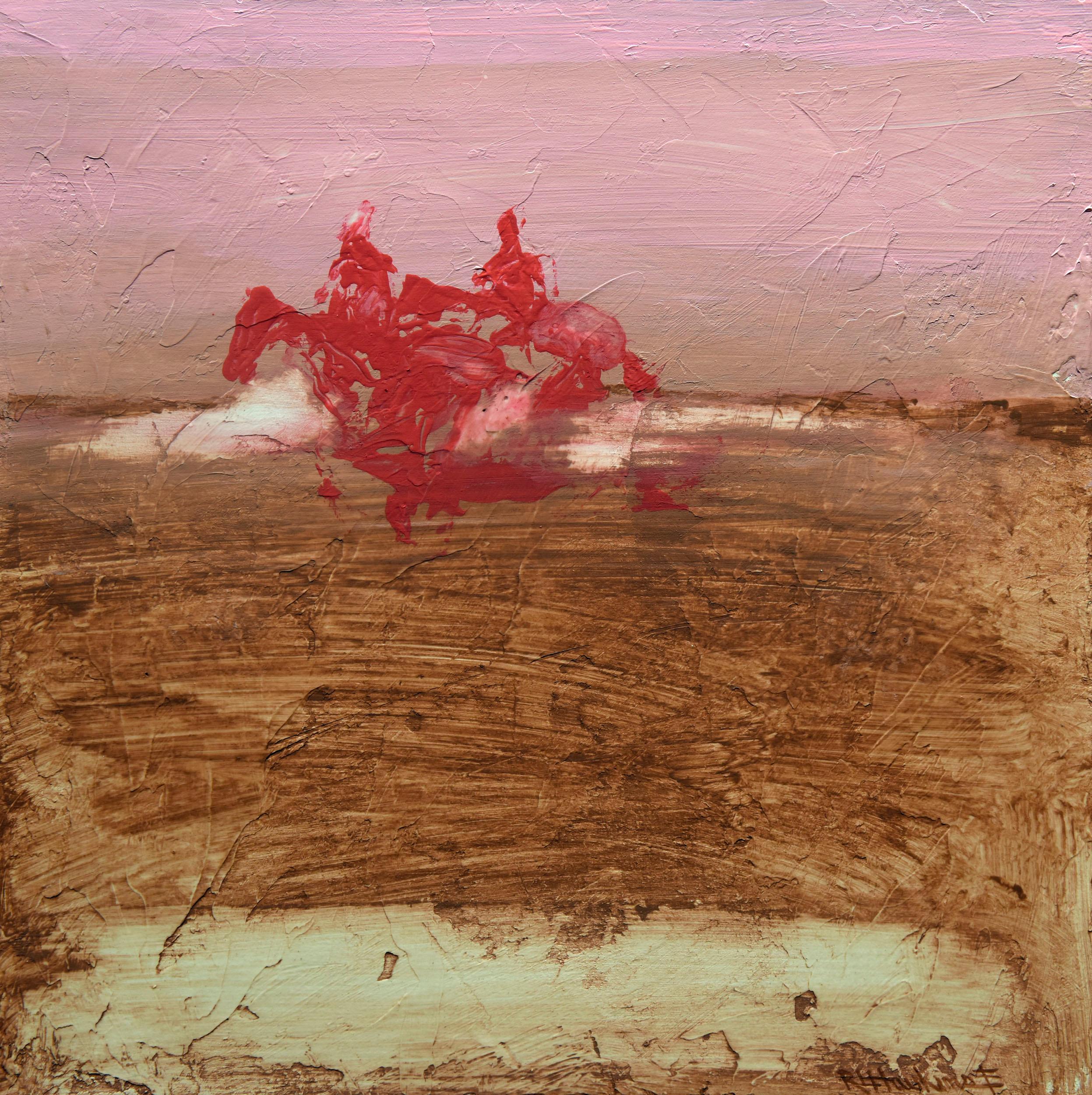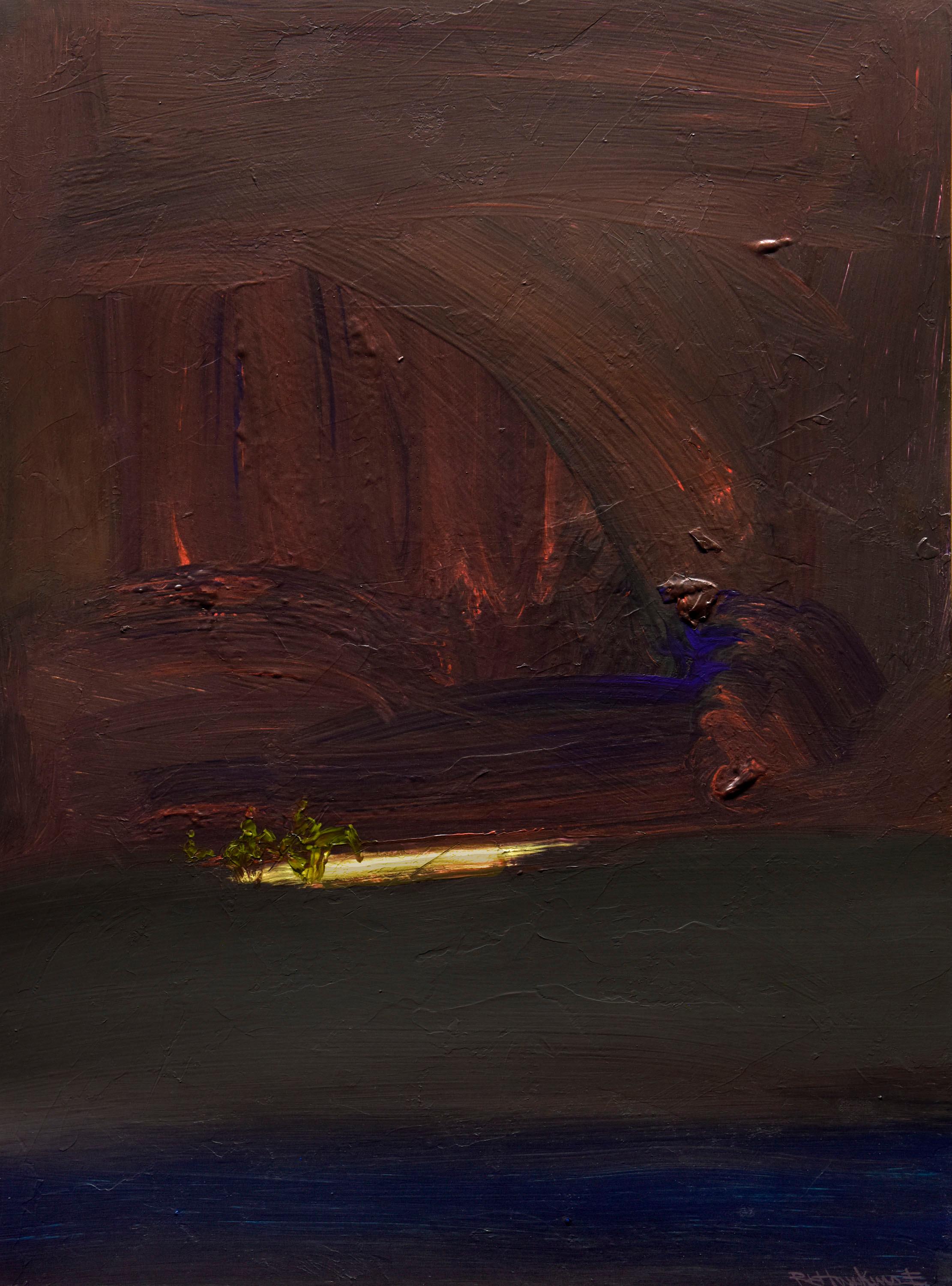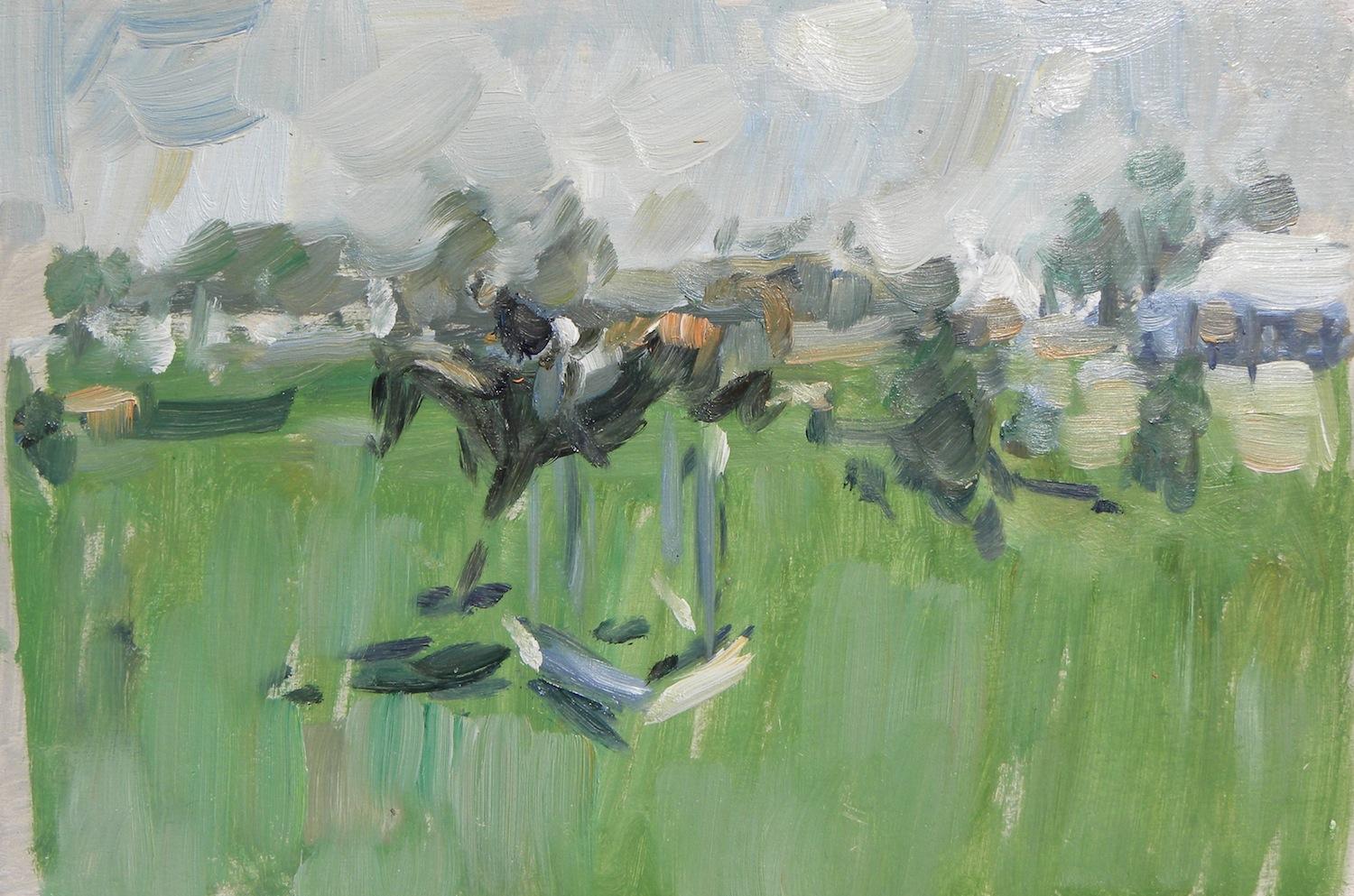Items Similar to Mod Abstract Expressionist Modernist Oil Painting Dog Drawing Edward Avedisian
Want more images or videos?
Request additional images or videos from the seller
1 of 7
Edward AvedisianMod Abstract Expressionist Modernist Oil Painting Dog Drawing Edward Avedisian c.1960's
c.1960's
About the Item
Edward Avedisian ( 1936-2007 )
7.5 X 5.75
Oil paint on wood panel
This is not signed on front. It bears his name verso.
Provenance: Hudson, N.Y. estate of noted Art Collector Albert Burnette Roberts (1932-2021)
Edward Avedisian (June 15, 1936, Lowell, Massachusetts – August 17, 2007, Philmont, New York) was an American abstract painter who came into prominence during the 1960s. His work was initially associated with Color field painting and in the late 1960s with Lyrical Abstraction and Abstract Expressionism. This work is reminiscent of later work by Hunt Slonem.
He studied art at the School of the Museum of Fine Arts, Boston. By the late 1950s he moved to New York City. Between 1958 and 1963 Avedisian had six solo shows in New York. In 1958 he initially showed at the Hansa Gallery, then he had three shows at the Tibor de Nagy Gallery and in 1962 and 1963 at the Robert Elkon Gallery. He continued to show at the Robert Elkon Gallery almost every year until 1975.
During the 1960s his work was broadly visible in the contemporary art world. He joined the dynamic art scene in Greenwich Village, frequenting the Cedar Tavern on Tenth Street, associating with the critic Clement Greenberg, and joining a new generation of abstract artists, such as Darby Bannard, Kenneth Noland, Jules Olitski, and Larry Poons.
Avedisian was among the leading figures to emerge in the New York art world during the 1960s. An artist who mixed the hot colors of Pop Art with the cool, more analytical qualities of Color Field painting, he was instrumental in the exploration of new abstract methods to examine the primacy of optical experience.
One of his paintings was appeared on the cover of Artforum, in 1969, his work was included in the 1965 Op Art The Responsive Eye exhibition at the Museum of Modern Art and in four annuals at the Whitney Museum of American Art. His paintings were widely sought after by collectors and acquired by major museums in New York and elsewhere. He has been exhibited in prominent galleries, such as the Anita Shapolsky Gallery and the Berry Campbell Gallery in New York City. Edward Avedisian was known for his brightly colored, boldly composed canvases that combined Minimalism's rigor, Pop art exuberance and the saturated tones of Color Field painting.
Roberta Smith of the NYT writes of Avedesian: "Edward Avedisian helped establish the hotly colored, but emotionally cool, abstract painting that succeeded Abstract Expressionism in the early 1960s. This young luminary harnessed elements of minimalism, pop, and color field painting to create prominent works of epic proportions that energized the New York art scene of the time." In 1996 Avedisian showed his paintings from the 1960s at the Mitchell Algus Gallery, then in SoHo. His last show, dominated by recent landscapes, was in 2003 at the Algus gallery, now in Chelsea.
Selected Exhibitions:
Op Art: The Responsive Eye, at the Museum of Modern Art,
Whitney Museum’s Young America 1965
Expo 67, held in Montreal, Canada.
Six Painters (along with Darby Bannard, Dan Christensen, Ron Davis, Poons, and Peter Young) , Albright-Knox Art Gallery in collaboration with the Baltimore Museum of Art and the Milwaukee Art Center.
Selected collections:
Albright-Knox Art Gallery, Buffalo, New York;
Brooklyn Museum, New York;
Denver Art Museum, Colorado;
Flint Institute of Arts, Michigan;
Metropolitan Museum of Art, New York;
Neuberger Museum of Art, Purchase, New York;
Parrish Art Museum, Southampton, New York;
Portland Art Museum, Oregon;
Smithsonian American Art Museum, Washington, D.C.;
Solomon R. Guggenheim Museum, New York;
University of Michigan Museum of Art, Ann Arbor;
Yale University Art Gallery, New Haven, Connecticut.
Museum of Modern Art,
Whitney Museum of American Art,
Berkshire Museum, Pittsfield, Massachusetts,
Wadsworth Atheneum, Hartford, Connecticut,
Los Angeles County Museum of Art, LACMA,
- Creator:Edward Avedisian (1936-2007, American)
- Creation Year:c.1960's
- Dimensions:Height: 7.5 in (19.05 cm)Width: 5.75 in (14.61 cm)
- Medium:
- Movement & Style:
- Period:
- Condition:good. please see photos.
- Gallery Location:Surfside, FL
- Reference Number:1stDibs: LU38212408412
About the Seller
4.9
Platinum Seller
These expertly vetted sellers are 1stDibs' most experienced sellers and are rated highest by our customers.
Established in 1995
1stDibs seller since 2014
1,546 sales on 1stDibs
Typical response time: 1 hour
- ShippingRetrieving quote...Ships From: Surfside, FL
- Return PolicyA return for this item may be initiated within 3 days of delivery.
More From This SellerView All
- Large Modernist French Abstract Expressionist Colorful Bird Painting Roger LersyBy Roger LersyLocated in Surfside, FLRoger Lersy, French (1920 - 2004) Oil on canvas Signed, R. Lersy, dated 1961 lower right Measuring 35 X 31 Matted and framed. sight 26 X 21.5 Roger Lersy was born in Paris, France 1920, in the rough neighborhood surrounding Place Pigalle. His youth was marked by extreme poverty. Lersy studied art and music at the École des Arts Apppliqués. He was a painter, lithographer and musician-composer He belongs to the École de Paris and was a member in the movement of the Young Painting. By 1946, when he first exhibited in Paris, Lersy became one of the founders of the School of Paris’ New Graphic School. Lersy received the Prix des Amateurs d’Art in 1953, the Shell Prize in 1954 and the Grand Prize of the City of Marseilles in 1953. Lersy could be defined as a Baroque expressionist. For Bernard Dorival, Roger Lersy is along with Gabriel Dauchot, Jean Commère and Raymond Guerrier among "the most noted champions of this expressionism which is part of the continuation of Bernard Buffet's miserabilism". Famous works: New Year's Eve , Aubusson tapestry of the Manufacture des Gobelins , Permanent Mission of France to the United Nations , One Dag Hammarskjöld Plaza , New York . Venice , bridges , watercolor, 1963 (theme of the Roger Lersy exhibition, Chicago). The poppy , original lithograph, Imprimerie Bellini, 1978, collection of the Cabinet des estampes , BNF . Still life at the pedestal table , oil on canvas, Jonzac town hall. Lohengrin , oil on canvas, Versailles Administrative Court of Appeal. Portrait of the painter Tony Agostini , drawing. Series Eiffel Tower. Stained glass: Saint-Laurent Church, Longlaville ( Meurthe-et-Moselle ), 29 stained glass windows. Musical works: Stained glasses for clarinet , saxophone, cello and percussion , creation in the church of Longlaville, 1972. Three pieces for two waves Martenot : 1. Scum of dream, 2. Scare and jubilation. Malicious connivance, sheet music Editions A. Leduc, Paris, 1979. Work for trumpet and piano , published by Éditions G. Billaudot, Paris, 1984. Five pieces for piano , scores published by G. Billaudot, Paris, 1989. Five preludes for piano and alto saxophone , scores at Éditions Combre, premiere at Flâneries musicales de Reims , 1993. In memory of Chagall , piece for flute and percussion , recording of Duo Hyksos (Henri Tournier, flute and Michel Gastaud, percussion) in 1995. Preface in black and yellow for horn and piano , score at Éditions Combre, Arc-en-ciel collection, 2000. Soundtracks: Diatomées Note 4 , 19 , film by Jean Painlevé...Category
1960s Abstract Expressionist Abstract Paintings
MaterialsOil, Acrylic, Canvas
- American Neo Expressionist Woman with Camels Abstract Modernist Oil PaintingBy Robert BeauchampLocated in Surfside, FLHand signed lower right, titled verso. Blue Woman with Seated Camels MIxed media oil painting on heavy art paper Robert Beauchamp (1923 – March 1995) was an American figurative painter and arts educator. Beauchamp's paintings and drawings are known for depicting dramatic creatures and figures with expressionistic colors. His work was described in the New York Times as being "both frightening and amusing,". He was a Guggenheim Fellow and a student of Hans Hofmann. Robert Beauchamp was born in Denver, Colorado in 1923. He had three brothers and three sisters, and the children were orphaned by both parents by the time Beauchamp was three. The family grew up impoverished due to the Great Depression, living in a community house with other families. As a child he dabbled in art but it wasn't until high school that he began taking art classes. When not creating art he also played sports; football and basketball, and enjoyed chemistry and geology. He was told he was good at drawing, and replaced study hall classes with art classes, receiving instruction and inspiration from a Welsh teacher named R. Idris Thomas. While in high school Beauchamp would go, every Monday, to the public library and a local museum where he would read books about art; specifically French painting, as assigned by Thomas. Beauchamp absorbed the tenets of European Modernism and American Abstract Expressionism—with which he eventually broke. While abstraction, with its focus on color and form, underlies his compositions, he filled canvas and paper with psychologically acute portraits of himself and others, nudes, animals, and objects of all kinds. Beauchamp would spend upwards of four hours a day in the art room and eventually won the Carter Memorial Prize, which provided a scholarship to the Colorado Springs Fine Arts Center. At Colorado Springs he studied under Boardman Robinson, painting landscapes in nature. Beauchamp eventually joined the Navy and then returned to Colorado Springs to continue his studies. Traveling the world as an Armed Guard, he spent a year and a half at sea and the rest of the three years in San Francisco. Seeking to make money, and to follow his love for a girl, Beauchamp decided to attend Cranbrook Academy of Art from 1947–1948. There he studied pottery, believing one could "make more money selling pots than you could selling paintings." He described his experience at Cranbrook as intimidating and claustrophobic, and eventually switched to sculpture before switching to painting. Beauchamp moved to New York City in the early 1950s and was involved in the Tenth Street galleries, which provided outlets for more experimental artists and the second generation of abstract expressionists. Despite his involvement with 10th Street and friendships with abstract artists, abstract art never interested in him. He showed at numerous galleries in New York and Provincetown, socializing with gallery owners, artists and collectors. His first exhibition was at the Tanager Gallery in New York, he also showed during the 1950s at the Hansa Gallery. In New York and Provincetown he studied under Hans Hofmann Eventually he felt that abstract expressionism became dull and stalemated. During the 1960s he showed at the Green Gallery. C. 1960 he was awarded a Fulbright Award allowing him to travel to La Romola, Italy. He traveled frequently to cities such as Rome and worked constantly. Beauchamp returned to the states and lived in Provincetown at Walter Gutman...Category
20th Century Neo-Expressionist Abstract Paintings
MaterialsPaper, Oil
- American Neo Expressionist "Wild Horses" Modernist Oil PaintingBy Robert BeauchampLocated in Surfside, FLSigned lower left. Robert Beauchamp (1923 – March 1995) was an American figurative painter and arts educator. Beauchamp's paintings and drawings are known for depicting dramatic crea...Category
20th Century Neo-Expressionist Abstract Paintings
MaterialsPaper, Oil
- American Neo Expressionist "Wild Horses" Modernist Oil PaintingBy Robert BeauchampLocated in Surfside, FLRobert Beauchamp (1923 – March 1995) was an American figurative painter and arts educator. Beauchamp's paintings and drawings are known for depicting dramatic creatures and figures w...Category
20th Century Neo-Expressionist Abstract Paintings
MaterialsPaper, Oil
- American Neo Expressionist Woman with Monkeys Abstract Modernist Oil PaintingBy Robert BeauchampLocated in Surfside, FLRobert Beauchamp, American (1923-1995) Untitled Hand signed lower right, titled verso. MIxed media oil painting on heavy art paper sight: 22 3/4 x 29 1/2 inches frame dimensions: 23 1/4 x 30 1/4 x 1 1/4 inches, metal frame with glazing Provenance: Private Collection. Frame inscribed 'Property of AT&T' Bears label from their corporate art collection. Robert Beauchamp (1923 – March 1995) was an American figurative painter and arts educator. Beauchamp's paintings and drawings are known for depicting dramatic creatures and figures with expressionistic colors. His work was described in the New York Times as being "both frightening and amusing,". He was a Guggenheim Fellow and a student of Hans Hofmann. Robert Beauchamp was born in Denver, Colorado in 1923. He had three brothers and three sisters, and the children were orphaned by both parents by the time Beauchamp was three. The family grew up impoverished due to the Great Depression, living in a community house with other families. As a child he dabbled in art but it wasn't until high school that he began taking art classes. When not creating art he also played sports; football and basketball, and enjoyed chemistry and geology. He was told he was good at drawing, and replaced study hall classes with art classes, receiving instruction and inspiration from a Welsh teacher named R. Idris Thomas. While in high school Beauchamp would go, every Monday, to the public library and a local museum where he would read books about art; specifically French painting, as assigned by Thomas. Beauchamp absorbed the tenets of European Modernism and American Abstract Expressionism—with which he eventually broke. While abstraction, with its focus on color and form, underlies his compositions, he filled canvas and paper with psychologically acute portraits of himself and others, nudes, animals, and objects of all kinds. Beauchamp would spend upwards of four hours a day in the art room and eventually won the Carter Memorial Prize, which provided a scholarship to the Colorado Springs Fine Arts Center. At Colorado Springs he studied under Boardman Robinson, painting landscapes in nature. Beauchamp eventually joined the Navy and then returned to Colorado Springs to continue his studies. Traveling the world as an Armed Guard, he spent a year and a half at sea and the rest of the three years in San Francisco. Seeking to make money, and to follow his love for a girl, Beauchamp decided to attend Cranbrook Academy of Art from 1947–1948. There he studied pottery, believing one could "make more money selling pots than you could selling paintings." He described his experience at Cranbrook as intimidating and claustrophobic, and eventually switched to sculpture before switching to painting. Beauchamp moved to New York City in the early 1950s and was involved in the Tenth Street galleries, which provided outlets for more experimental artists and the second generation of abstract expressionists. Despite his involvement with 10th Street and friendships with abstract artists, abstract art never interested in him. He showed at numerous galleries in New York and Provincetown, socializing with gallery owners, artists and collectors. His first exhibition was at the Tanager Gallery in New York, he also showed during the 1950s at the Hansa Gallery. In New York and Provincetown he studied under Hans Hofmann Eventually he felt that abstract expressionism became dull and stalemated. During the 1960s he showed at the Green Gallery. C. 1960 he was awarded a Fulbright Award allowing him to travel to La Romola, Italy. He traveled frequently to cities such as Rome and worked constantly. Beauchamp returned to the states and lived in Provincetown at Walter Gutman...Category
20th Century Neo-Expressionist Abstract Paintings
MaterialsPaper, Oil
- Mixed Media Collage, Graphite, Oil Painting Abstract Expressionist Henry MandellLocated in Surfside, FLHenry Mandell was born in New York City where he continues to live and work. He also maintains a studio is in the Pacific Northwest, with production facilities in New York City. Trai...Category
1980s Abstract Expressionist Mixed Media
MaterialsOil, Graphite
You May Also Like
- Transformation No. 8By Rocky HawkinsLocated in Denver, COEnthralled with the lore and spirituality of American Indian cultures, his work often depicts these traditional subjects in nontraditional ways. Hawkins captures the raw sense of ele...Category
2010s Abstract Expressionist Abstract Paintings
MaterialsMixed Media, Oil, Acrylic, Wood Panel
- Shine in SilenceBy Rocky HawkinsLocated in Denver, COEnthralled with the lore and spirituality of American Indian cultures, his work often depicts these traditional subjects in nontraditional ways. Hawkins captures the raw sense of ele...Category
2010s Abstract Expressionist Abstract Paintings
MaterialsMixed Media, Oil, Acrylic, Wood Panel
- The Derby, Wellington FLABy Ben FenskeLocated in Sag Harbor, NYA gestural painting of a horse and rider landing from jumping an oxer in a large green field in sunny Florida.Category
2010s Abstract Expressionist Animal Paintings
MaterialsOil, Panel
- Untitled, Cat and RoosterBy Paul RandLocated in Miami, FLThe work represents a wide eye cat staring at a rooster. The work is as simple as it's complex. The negative space is as important as the positive space. It's as sophisticated as it'...Category
1940s Abstract Expressionist Animal Paintings
MaterialsAcrylic, Pencil
- "Found Fat" (Abstract, Neutral, Skull, Bold, Graphic, Type, Text, Red, Green)By Nicholas EvansLocated in Paris, IDFFOUND FAT 2020 Paris, France Bold, hand-painted, serif typography, painted over a lion's skull on a stained, gessoed canvas. The words read: "Found Fat," mirrored in a vivid green ...Category
21st Century and Contemporary Abstract Abstract Paintings
MaterialsCanvas, Oil, Acrylic, Graphite
- Kunsthaus GardenBy Mary VernonLocated in Dallas, TX"In the world of still life and landscape, conceptual events meet one another – the structural meets the narrative, the small stands in the space of the large, and color has a chance...Category
2010s Contemporary Abstract Paintings
MaterialsGraphite, Oil, Panel
Recently Viewed
View AllMore Ways To Browse
Ron C Mitchell
R And Y August
Ron Davis
Hunt Slonem Skippers
Hunt Slonem Tabernacle
James Barenger The Hunt
Jane Cozart
Jason Wheatley
Jeong Seongjoon
Jerome Snyder
Jillian Fitzmaurice
John Cyril Harrison On Sale
John Miles Of Northleach
Manu Munoz
Maryline Lemaitre
Maxwell Carrousel
Michael Sanders A Walk At Low Tide
Miss Coote





